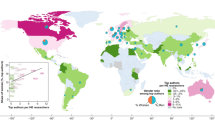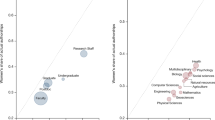Abstract
On the basis of survey, conducted within the framework of the UNESCO International Comparative Study on the Organization of Research groups, the role and position of women in scientific activity is compared. Data on a total of (6000 individuals) from Argentina, India, Egypt, Korea, Poland and USSR show that women scientists' participation is highest in Poland, and lower in India, Korea and Argentina. Everywhere women scientists are more often doing the routine aspects of the research process and more isolated from external contacts with men. Women have lower scientific productivity than male scientists which can be interpreted as a consequence of their lower status in the organization.
Similar content being viewed by others
References
J. BRONOWSKI, The Ascent of Man, British Boradcasting Corporation, London, 1973, p. 59.
On this point see, C. A. MAKINNON, Feminism, Marxism, Method and the State: an agenda for theory, Signs:Journal of Women in Culture and Society, (Special issue on feminist theory), Vol. 7., No. 3, 1982.
UNESCO, Division of Statistics on Science and Technology,Participation of women in R & D-A Statistical Study, September, 1980.
A. KELLY, A discouraging process: How women are eased out of science, Paper presented at the Conference on Girls and Science Education, Chelsea College, March 19–20, 1975,Bulletin of Science, Technology and Society, Vol. 3, Pergamon Press Ltd., U.S.A., 1983.
E. E. MACCOBY, Feminine intellect and the demands os science,Impact of Science of Society, 20 (1970), No. 1, 13.
D. GRIFFITHS,Women and Science: A Women replies, in SISCON by Kate Hinton, 1976, p. 611.
National Science Foundation Report, Women and Minorities in Science and Engineering, 1984.
D. RICHTER, Opportunities for Women in Science, in:Women Scientist: The road to Liberation, D. RICHTER (Ed.), 1982.
P. HUNYA, POSCOR—Mathematical Background & Description of the Programme, UNESCO/NS/ROU/603-Part-1, 1983.
V. STOLTE-HEISKANEN, M. ALESTALO, The Microcosmos of research activity: Research Groups and Effectiveness, 1978.
C. C. PERRUCCI, The Female Engineer and Scientists: Factors Associated with the Pursuit of a Professional Career, unpublished report, 1968.
B. M. SMITH, in:Socialisation and Society, J. A. CLAUSEN (Ed.), Little, Drawn Boston, 1968.
C. F. EPSTEIN,Women's Place, University of California Press, Berkeley, 1970.
A. ROE,The Making of Scientist, New York.
R. CHAKRAVARTHY, Productivity of Indian women scientists,Productivity, XXVIII, 3 (1986) 259.
Author information
Authors and Affiliations
Rights and permissions
About this article
Cite this article
Chakravarthy, R., Chawla, A. & Mehta, G. Women scientists at work—An international comparative study of six countries. Scientometrics 14, 43–74 (1988). https://doi.org/10.1007/BF02020242
Received:
Issue Date:
DOI: https://doi.org/10.1007/BF02020242




